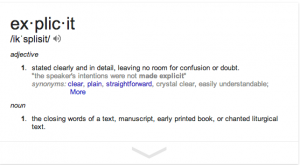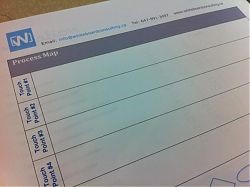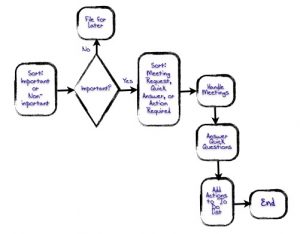Working from home has many advantages. The fact that I just had a powernap with the dogs curled up at my feet is one of them. The other also happened today: one too many glasses of wine at girls night, and I was not so pretty this morning. On went the sweatpants and off I went to conduct business in the comfort of my living room. What convenience! No commute. No fussy office attire. Hair and makeup? No thanks. #sorrynotsorry
Companies are on a mission to cut costs and tele-commuters and flexible work arrangements are on the rise. Teleconferences are (when executed well), an efficient and cost effective way to get things done.
A colleague of mine sent me this the other day after a particularly painful teleconference.
As comical as that was, the real truth is teleconferences can often be frustrating and ineffective. Whiteboard has a few simple tips to make your teleconferences better, faster, and cheaper. Behold! Whiteboard’s Ultimate Cheat Sheet on Effective Teleconferences (Click to Tweet):
Whiteboard’s Ultimate Cheat Sheet on Effective Teleconferences
1. The right medium.
First before deciding to hold a teleconference, ensure that it will be the right medium. Teleconferences are great for information sharing and questions. In-person meetings are better for decision making, complex problem solving, brainstorming, or decision-making.
2. An Agenda.
Create an agenda and use it. Clearly state the objective of the meeting and expected outputs and timing. People will be better prepared when they understand why they are there. Also feel free to place some of the tips for participants in the agenda (particularly #3).
3. Mute & Speakerphone.
I’m going to say this only once. Use this cute (and not nearly as crude as my last) helpful mnemonic:
AMPLUS =>
Always
Mute
Please &
Limit
Using
Speakerphone.
No one wants to hear you masticate, your yappy dog greet the mailman, or your heavy breathing. Nor do you need to sound like Darth Vader. Speakerphone quality is horrible compared to a mouthpiece, and all these extra sounds make it worse. AMPLUS. Catchy, eh?
4. Make it personal.
Have everyone on the line introduce themselves and their role/title. Make sure people’s ideas are heard. If you know Sally had questions about the budget yesterday, but all you hear is radio silence when you’ve finished presenting, call it out with a conversation starting open-ended question: “Sally, what are your thoughts on the budget?” or “Doug, this indicates some significant cuts to your division’s budget. How will this impact you?”
Note: this also keeps people alert and focused (i.e. not checking email, playing CandyCrush, or making breakfast). Ruth did this to me on a teleconference the other day and I was MORTIFIED because I had just looked away to read an email and had no idea where they were in the document. #teleconferencefail
5. The 10-second rule.
Without seeing facial expressions, it’s often hard to gauge how people are reacting to the content you are delivering. Often, people’s natural reactions are to fill that glorious muted silence with more of their own cherubic voice. They never take a breath for anyone to jump in. Or worse, they say “Any questions?” (Olympic 0.000037s pause). “Great Thanks. Talk Next week. “. Allowing a whole 10 seconds (1 Mississippi, 2 Mississippi……) allows for that awkward silence to penetrate and 9 times out of 10 someone (or more than one) will pipe up with a great question or comment that will spur discussion and make your call an effective use of time.
Like these tips? Have some funny teleconference stories to share? Give us a shout at @whiteboardcons!
Until next time,
Nicole











 As we continue along our process improvement journey we focus today on PROVE IT!
As we continue along our process improvement journey we focus today on PROVE IT!




